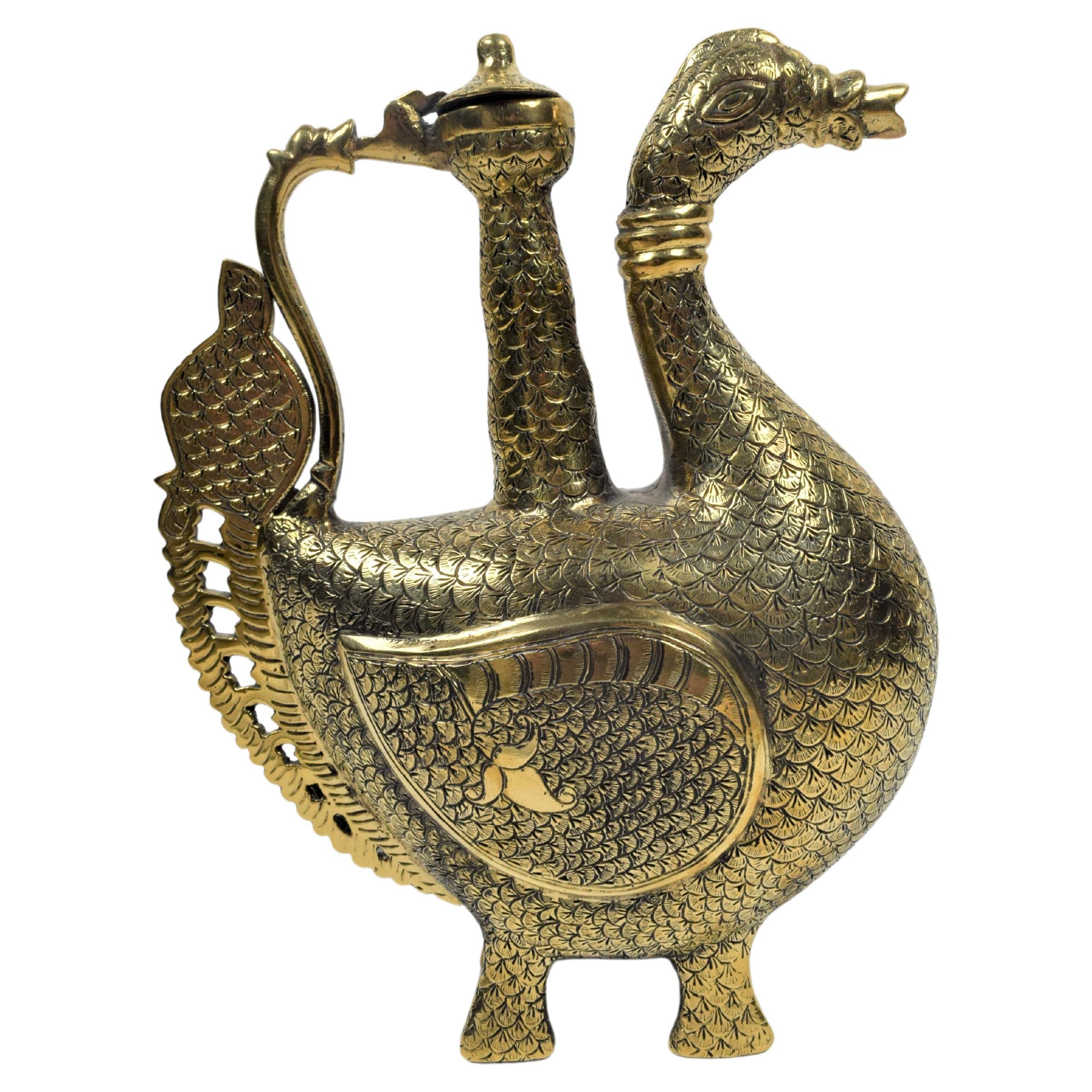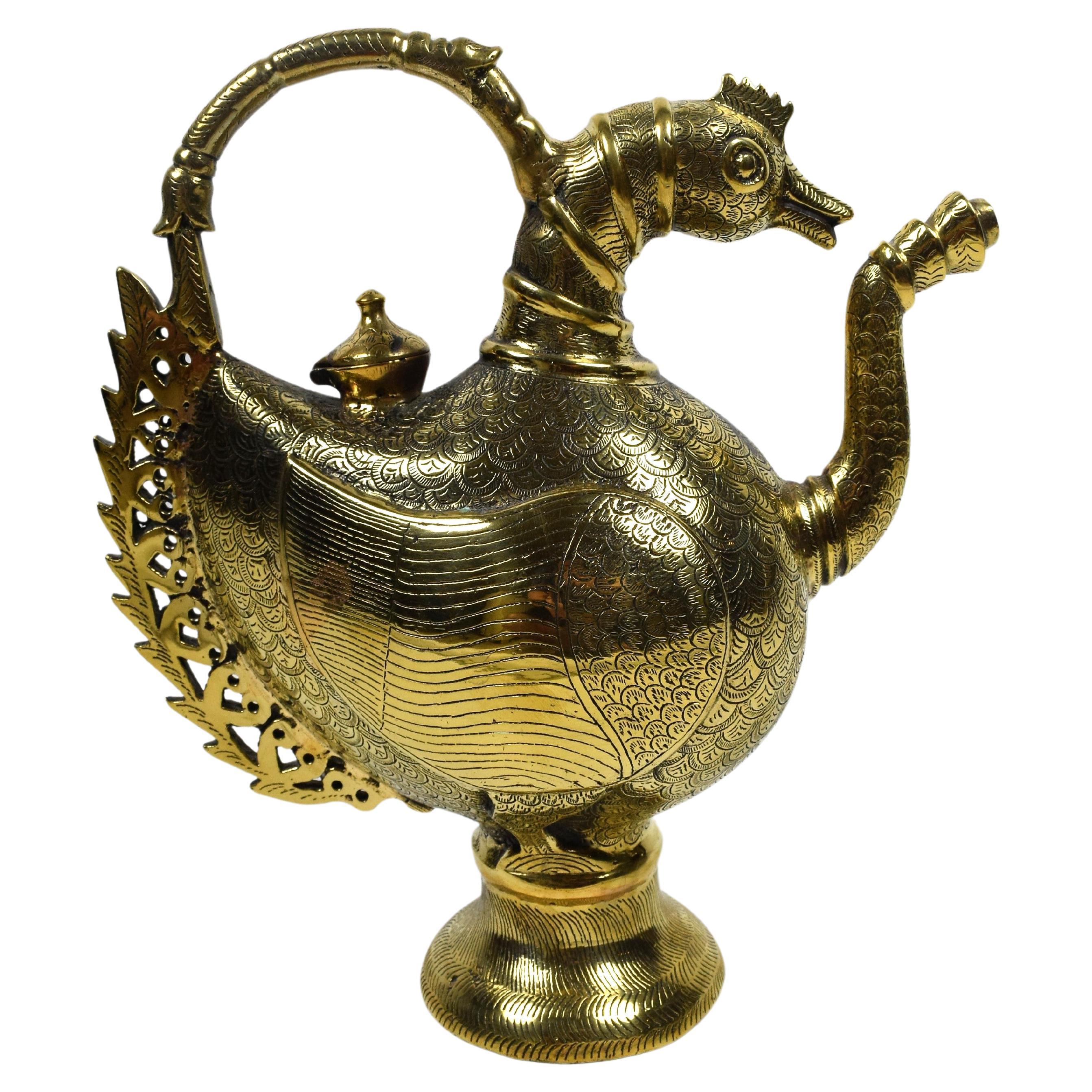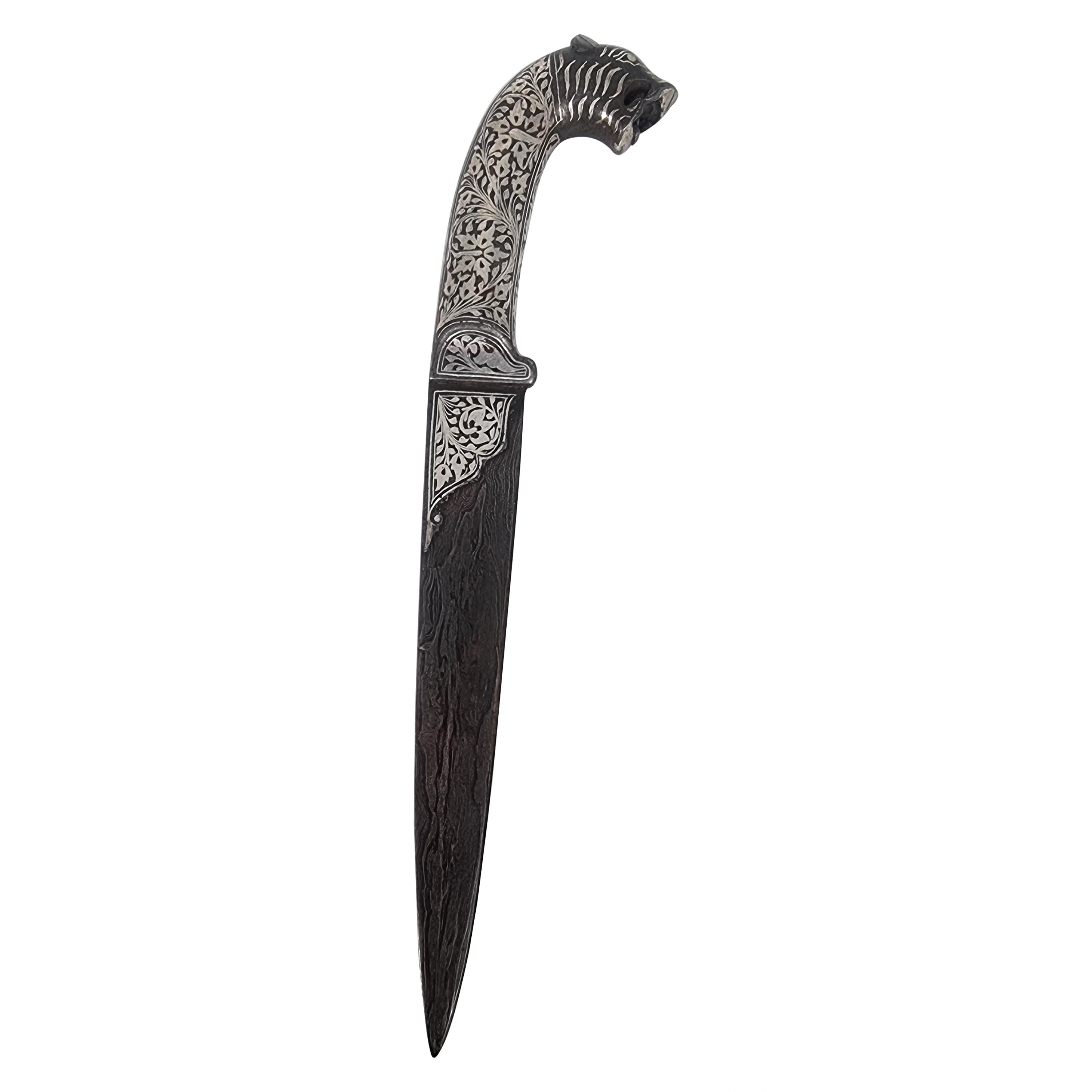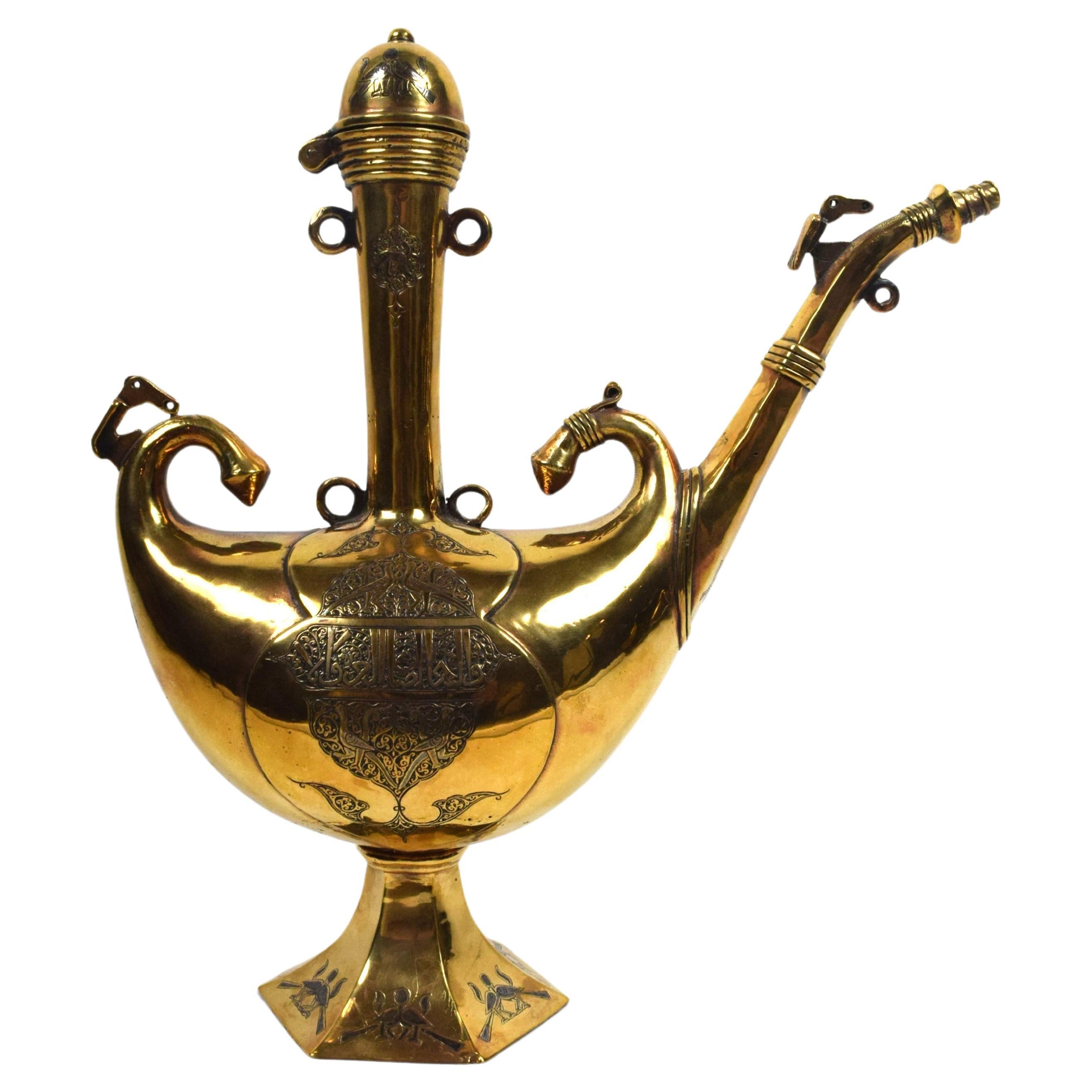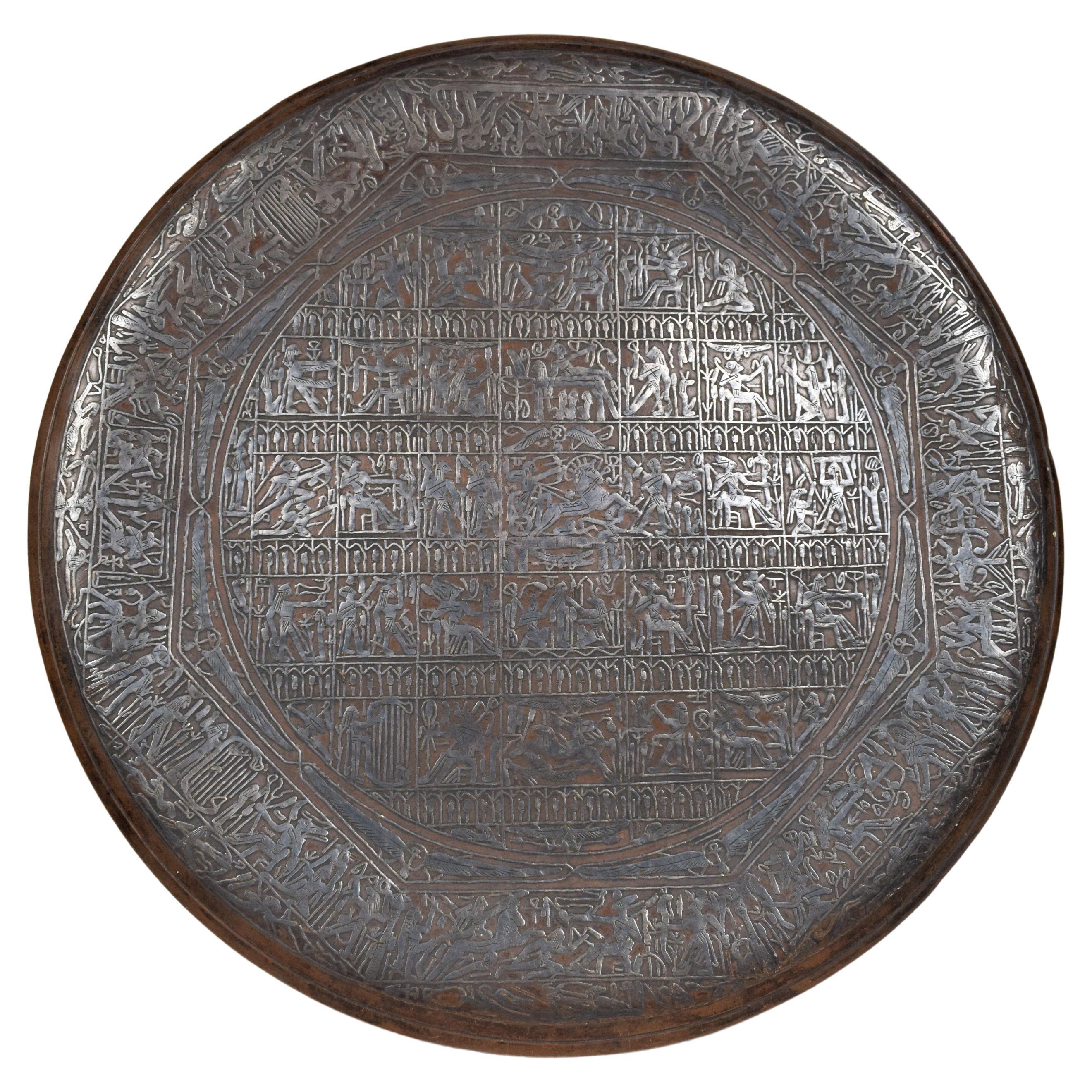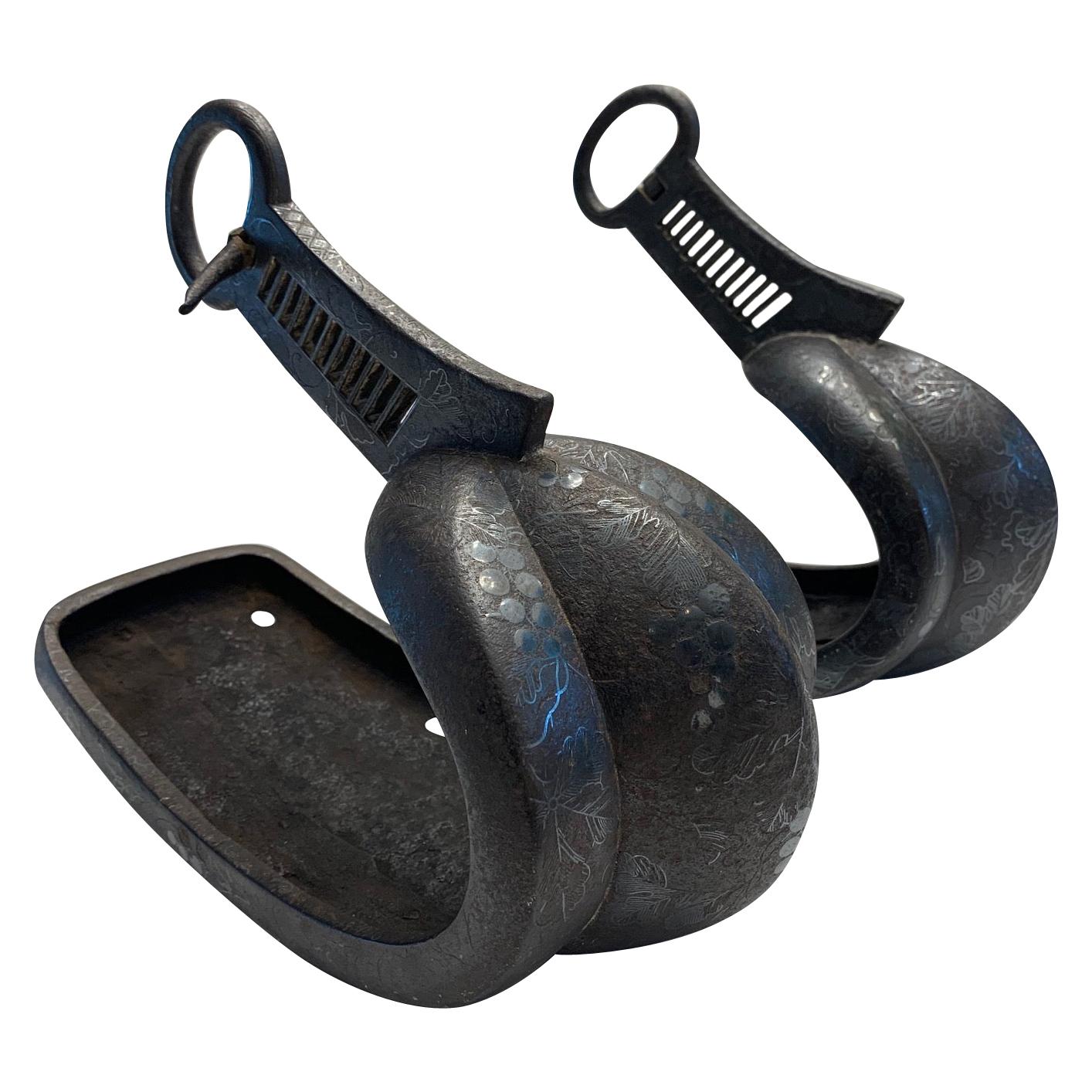Items Similar to Pair of Metal Mughal Horse Stirrups with Silver Inlay, 19th Century
Want more images or videos?
Request additional images or videos from the seller
1 of 8
Pair of Metal Mughal Horse Stirrups with Silver Inlay, 19th Century
About the Item
Thepair of metal Mughal horse stirrups with silver inlay, dating back to the 19th century, are astriking example of equestrian equipment reflecting the artistry and craftsmanship of the Mughal period.
The stirrups are made of a durable metal, providing strength and functionality. The utilitarian aspect of the stirrups is complemented by intricate silver inlay work, showcasing the Mughal penchant for detailed ornamentation.
The silver inlay is skillfully embedded into the metal surface, forming decorative patterns that include geometric designs. The inlay work not only serves as an aesthetic purpose but also exhibit a high level of craftsmanship, showcasing the technical skill of Mughal artisans.
The design of the stirrups is ergonomic, ensuring comfort and stability for the rider. The curvature and shape of the stirrup reflect the Mughal understanding of both practicality and elegance in equestrian equipment.
Given the Mughal affinity for luxury and opulence, the silver inlay might also depict elements of courtly life or Mughal symbolism.
The stirrups would have been functional components of a horse's tack, used for supporting the rider's feet and providing stability during various equestrian activities. The combination of sturdy metal construction with intricate silver inlay not only served a practical purpose but also transformed the stirrups into objects of artistic and cultural significance.
Overall, this pair of Mughal horse stirrups from the 19th century would be a fascinating blend of form and function, embodying the Mughal commitment to craftsmanship, luxury, and aesthetic beauty in everyday objects.
- Dimensions:Height: 9 in (22.86 cm)Width: 5 in (12.7 cm)Depth: 2 in (5.08 cm)
- Style:Anglo Raj (In the Style Of)
- Materials and Techniques:
- Place of Origin:
- Period:
- Date of Manufacture:19th Century
- Condition:Wear consistent with age and use.
- Seller Location:Islamabad, PK
- Reference Number:1stDibs: LU8147237300642
About the Seller
No Reviews Yet
Vetted Seller
These experienced sellers undergo a comprehensive evaluation by our team of in-house experts.
Established in 1947
1stDibs seller since 2023
10 sales on 1stDibs
- ShippingRetrieving quote...Ships From: Islamabad, Pakistan
- Return PolicyA return for this item may be initiated within 14 days of delivery.
More From This SellerView All
- Mughal Brass Peacock Engraved Ewer, Late 19th CenturyLocated in Islamabad, PKThe ewer, a ceremonial pitcher, is shaped in the form of a majestic peacock, a significant motif in Mughal art symbolizing beauty, grace, and regality. The body of the ewer is crafte...Category
Antique Late 19th Century Indian Anglo Raj Metalwork
MaterialsBrass
- Mughal Brass Peacock Engraved Ewer, Late 19th CenturyLocated in Islamabad, PKThe ewer, a ceremonial pitcher, is shaped in the form of a majestic peacock, a significant motif in Mughal art symbolizing beauty, grace, and regality. The body of the ewer is crafte...Category
Antique Late 19th Century Indian Anglo Raj Metalwork
MaterialsBrass
- Persian Brass Ewer With Silver Inlay Calligraphy, Mid 19th CenturyLocated in Islamabad, PKThe brass Persian Islamic ewer from the mid-19th century is a stunning example of craftsmanship and artistic expression. This ewer is not only a functiona...Category
Antique 19th Century Persian Islamic Metalwork
MaterialsSilver, Brass
- Egyptian Copper Plate with Silver Inlay Hieroglyphics, Early 19th CenturyLocated in Islamabad, PKThe large-scale copper charger plate with silver inlay is a truly awe-inspiring work of art. Its grand size and intricate design make it a captivating piece that commands attention a...Category
Antique 19th Century Egyptian Egyptian Antiquities
MaterialsSilver, Copper
- Mughal Indian Betel Nut Cutter, Mid 19th CenturyLocated in Islamabad, PKA 19th-century Mughal brass betel nut cutter, also known as a "sarota" in the Indian subcontinent, is a fine example of the exquisite craftsmanship an...Category
Antique 19th Century Indian Anglo Raj Antiquities
MaterialsSilver, Brass
- Kashmiri Mughal Copper Engraved Tray, Early 19th CenturyLocated in Islamabad, PKThe leaf-shaped copper tray from 19th-century Kashmir seamlessly blends the grace of nature with the opulence of Mughal design. Crafted with meticulous attention to detail, the tray'...Category
Antique 19th Century Indian Anglo Raj Platters and Serveware
MaterialsCopper
You May Also Like
- A 19th century Indian silver inlaid dagger with a Damascus steel blade, C 1870Located in Central England, GBA fine 19th-century ornate Indian dagger superbly made from hand forged folded steel known as Damascus which shows on the blade with a pattern almost like wood grain. The whole knife is made from solid steel and the handle is most elaborate with a curved grip which terminates in a tiger’s head all of which is profusely inlaid with finely cut silver in foliate patterns and panels with realistic markings to the tiger's head. This fine and interesting antique knife would be a good addition to any collection or would be very useful on a desk as a paper or letter opening knife. Some history on the Damascus steel: The history of Damascus steel can be traced all the way back to 500 A.D. when in India it was called Telangana, Wootz or Ukku steel. It then found its way to Damascus, Syria, which was the centre of trade in that region for war equipment such as knives, swords and armour. The name “Damascus” wasn’t adopted until the time of the Crusaders. The Crusaders witnessed Damascus swords...Category
Antique Late 19th Century Indian Anglo Raj Metalwork
MaterialsSilver, Steel
- Antique Japanese Iron Stirrups with Silver Inlay SignedLocated in Atlanta, GAA pair of antique Japanese Abumis, stirrup for horse-riding, in cast iron with elaborate silver inlay, circa 16th century Muramachi to Momoyama period. The prototype of Japanese abum...Category
Antique 16th Century Japanese Japonisme Metalwork
MaterialsSilver, Iron
- Pair 19th Century Chinese Lead Vases Inlayed with Bronze LampsLocated in Hudson, NYThis pair of vases are from China. Made as part of a 19th century alter garniture set the pair are now lamps. Cast in lead which has been inlayed with bronze decorative elements incl...Category
Antique 1880s Chinese Archaistic Table Lamps
MaterialsBronze, Lead
- 19th Century Mughal India Raj Style Silver Traditional Anklet Bracelet CatchallLocated in North Hollywood, CALate 19th century Mughal Indian Raj Style Silvered Traditional Anklet Bracelet from India repurposed as a vide poche, catchall, bowl ashtray or just as a beautiful collectible decorative object from India. Antique silver coin and brass heavy metal Dhokra ethnic tribal ankle bracelet that has been repurposed with a brass inner plate that was later added to use the bracelet as a small ashtray or decorative vanity jewelry bowl. The closure was a push pin mechanism that was closed. Dhokra art old ethnic tribal brass traditional ankle bracelet from India, handcrafted of a hollow band of heavy brass decorated with chevron repoussé banding and lost wax granulation. Measures: Height : 1.5 inches. Length : 7.5 inches. Width : 7.5 inches. Diameter: 7.5 inches Brass silver plated. Rare collectible decorative bowl, catchall, ashtray, Mughal Raj style, North India, Rajasthan. Circa 1900's Weight= 2 Lb 6.9 oz Anklets were important components in a suite of jewels worn by women in India. These very heavy examples are fabricated in two pieces, and tightly secured with a near-invisible pin. Some legends suggest that heavy anklets like these could weigh up to 20 pounds and were used to prevent brides from running away from their new families. How it is made: "Dhokra is an ancient folk art tradition prevalent in India in the eastern states of West Bengal, Odisha, Jharkhand and Chhattisgarh. Dhokra craft objects are made through the process of non-ferrous metal casting using the lost-wax casting technique, which is one of the earliest and most advanced methods of metal casting known to human civilization. Its roots can be traced back 4500 years to the ancient city of Mohenjodaro in the Indus Valley Civilization. The name Dokra or Dhokra was used to indicate a group of craftsmen of nomadic type from the Dhokra Damar tribe, scattered over the regions of Bengal, Orisa and Madhya Pradash, whose wares were identified by their beautifully shaped and decorated metal products. The enchanting Dhokra art objects have motifs inspired by indigenous folk...Category
Antique Early 1900s Indian Islamic Metalwork
MaterialsSilver Plate, Brass
- 19th Century Indo Persian Mughal Tinned Copper BowlLocated in North Hollywood, CALarge 19th century tinned copper Indo Persian Mughal copper bowl vessel. Great patina on handcrafted and embossed metal tin copper bowl with floral geo...Category
Antique 19th Century Indian Moorish Metalwork
MaterialsCopper, Tin, Bronze
- 19th Century Mughal Indo Persian Footed Tinned Copper BowlLocated in North Hollywood, CAMughal Islamic Indo Persian red copper footed bowl, of compressed hemispherical shape, resting on a splayed conical foot, with slightly everted rim,...Category
Antique Late 19th Century Indian Moorish Metalwork
MaterialsMetal, Copper
Recently Viewed
View AllMore Ways To Browse
Tibetan Singing
Hammered Urli Vessel With Handles
Antique Brass Towel Ring
Chinese Belt Hook
Solid Perfume Container
Bronze Elephant Incense
Japanese Bronze Brazier
Tetsubin Teapot
Bronze Bears With Tray
Cloisonne With Gold Flake
Meiji Bronze Buddha
Chinese Plique A Jour Box
Louis Vuitton Mens Cuff
Antique Kick Scooters
Antique Toy Scooters
Asian Trumpet Shape Brass Vase
Bronze Koi Vase
Chinese Bronze Kettle
